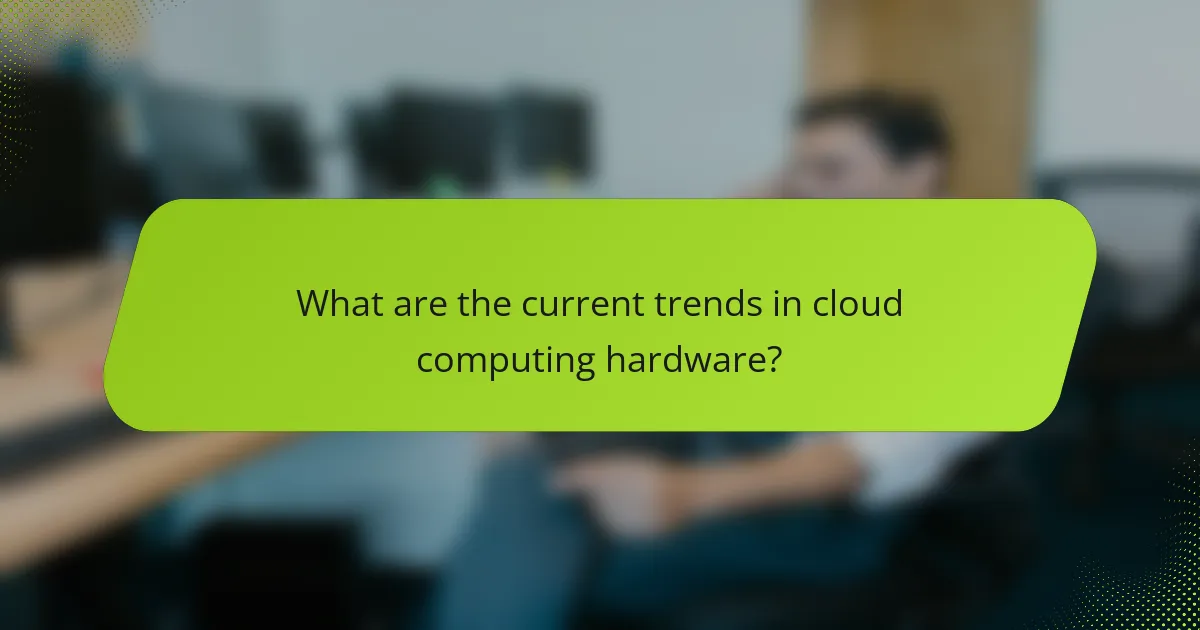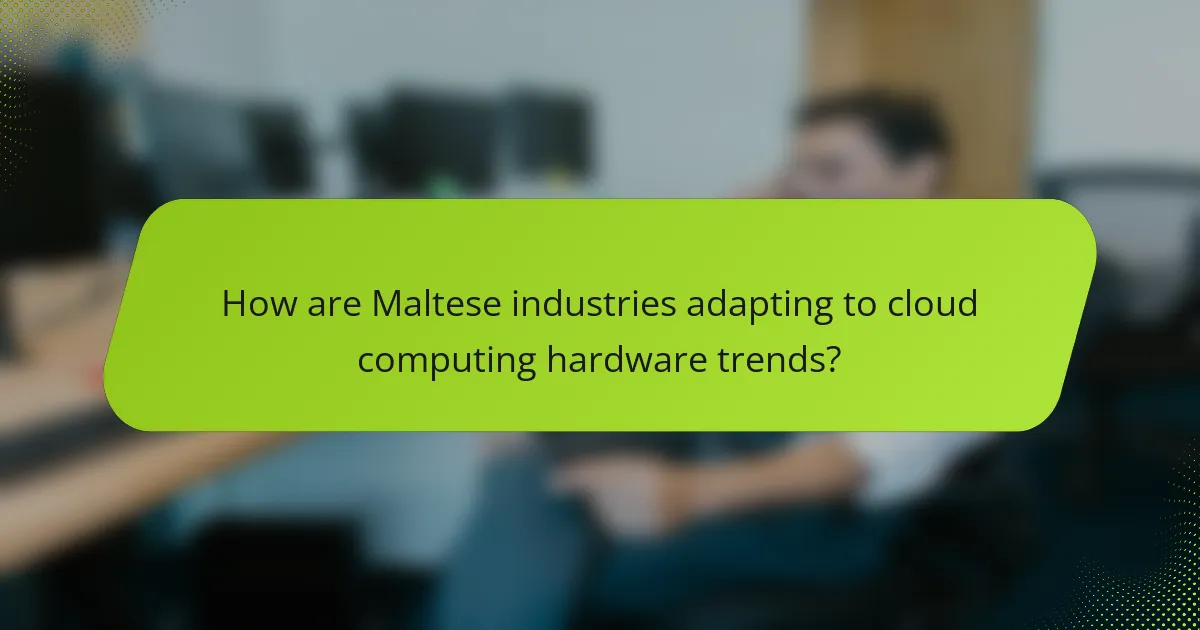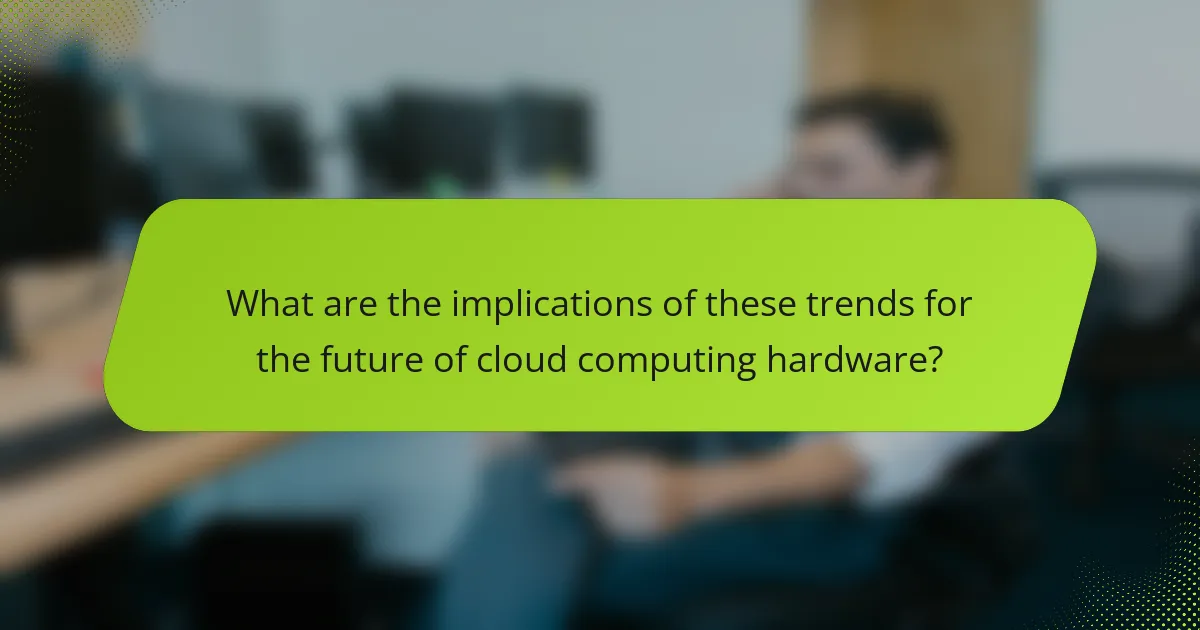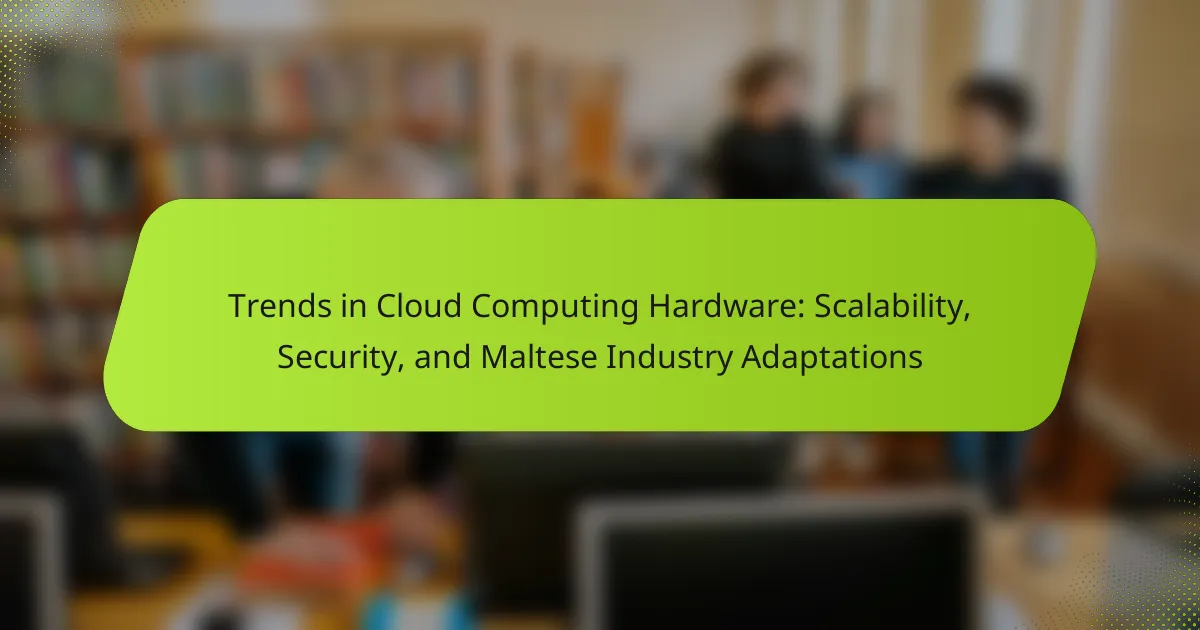
What are the current trends in cloud computing hardware?
Current trends in cloud computing hardware include increased use of specialized processors and enhanced security features. Companies are adopting field-programmable gate arrays (FPGAs) and graphics processing units (GPUs) for optimized performance. These processors accelerate data processing and improve efficiency in AI and machine learning tasks. Additionally, hardware security modules (HSMs) are becoming standard to safeguard sensitive data. The shift towards edge computing is also notable, allowing data processing closer to the source. This reduces latency and improves response times for applications. Furthermore, there is a growing emphasis on energy-efficient hardware to meet sustainability goals. These trends indicate a focus on performance, security, and environmental responsibility in cloud computing hardware.
How is scalability shaping the future of cloud computing hardware?
Scalability is a key factor influencing the future of cloud computing hardware. It allows systems to efficiently manage increasing workloads and user demands. As businesses grow, their IT resources must adapt seamlessly. This adaptability leads to more flexible and cost-effective solutions. Companies can scale up or down based on their needs. Research shows that 94% of enterprises report improved performance with scalable cloud solutions. Enhanced scalability also fosters innovation by enabling rapid deployment of new applications. Overall, scalability is essential for optimizing resource allocation and maximizing operational efficiency in cloud computing.
What are the key aspects of scalability in cloud computing?
Scalability in cloud computing refers to the ability to efficiently increase or decrease resources based on demand. Key aspects include vertical scalability, which involves adding resources to a single node. This can enhance performance but may have limits. Horizontal scalability involves adding more nodes to a system. This approach allows for greater flexibility and can handle larger loads. Elasticity is another critical aspect, enabling dynamic resource allocation as demand fluctuates. This ensures cost-effectiveness and optimal performance. Additionally, automated scaling tools help manage resources without manual intervention. According to a report by Gartner, 70% of organizations see scalability as a primary factor in cloud adoption.
How do different cloud service models influence scalability?
Cloud service models significantly influence scalability by defining how resources are allocated and managed. Infrastructure as a Service (IaaS) offers the most flexibility. It allows users to scale resources up or down based on demand. This model enables businesses to manage their own servers and storage.
Platform as a Service (PaaS) provides a middle ground. It allows developers to focus on application development without worrying about underlying infrastructure. PaaS scales automatically to accommodate varying workloads.
Software as a Service (SaaS) typically offers the least control over scalability. Users rely on the provider to manage resources. However, SaaS solutions can still scale efficiently through multi-tenancy.
Overall, IaaS provides the highest level of scalability, followed by PaaS and then SaaS. Each model’s architecture and management capabilities directly impact how effectively a business can scale its operations.
What security measures are being integrated into cloud computing hardware?
Cloud computing hardware is integrating several key security measures. These include hardware-based encryption to protect data at rest and in transit. Secure Boot is being implemented to ensure only trusted software runs on devices. Additionally, Trusted Platform Modules (TPMs) are utilized to provide hardware-level security features. Multi-factor authentication is increasingly standard for accessing cloud resources. Regular firmware updates are mandated to address vulnerabilities and enhance security. Network segmentation is applied to isolate sensitive data and applications from public access. Furthermore, intrusion detection systems are integrated to monitor and respond to security threats in real-time. These measures collectively enhance the overall security posture of cloud computing hardware.
What are the primary security challenges faced by cloud computing?
The primary security challenges faced by cloud computing include data breaches, loss of control over data, and inadequate security measures. Data breaches occur when unauthorized users access sensitive information stored in the cloud. According to a 2021 report by IBM, the average cost of a data breach is $4.24 million. Loss of control happens when organizations outsource data management to third-party cloud providers. This can lead to compliance issues and potential legal liabilities. Inadequate security measures refer to insufficient encryption, weak access controls, and poor security configurations. A study by McAfee found that 21% of organizations do not have a clear understanding of their cloud security posture. These challenges highlight the need for robust security strategies in cloud computing environments.
How do hardware advancements improve security in cloud environments?
Hardware advancements improve security in cloud environments by enhancing encryption capabilities and enabling better access control. Modern processors often include built-in security features like hardware-based encryption. This reduces the risk of data breaches during transmission and storage. Additionally, advancements in security chips, such as Trusted Platform Modules (TPMs), provide secure key management. These chips protect sensitive information from unauthorized access.
Moreover, improved network hardware allows for better traffic monitoring and anomaly detection. This helps identify potential threats in real-time. Enhanced physical security measures, such as biometric access controls, further protect data centers. These advancements collectively contribute to a more secure cloud infrastructure.

How are Maltese industries adapting to cloud computing hardware trends?
Maltese industries are increasingly adopting cloud computing hardware trends to enhance efficiency and scalability. Many companies are migrating their data storage and processing to cloud platforms. This shift allows for better resource management and reduced operational costs. Additionally, businesses are investing in hybrid cloud solutions for flexibility. They are also focusing on improving data security measures to protect sensitive information in the cloud. Recent statistics show that over 60% of Maltese firms have integrated cloud services into their operations. This trend reflects a growing reliance on technology for competitive advantage.
What specific challenges do Maltese industries face in cloud adoption?
Maltese industries face several specific challenges in cloud adoption. Limited internet connectivity affects reliable access to cloud services. High costs associated with cloud migration deter smaller businesses from transitioning. Data security concerns arise due to the sensitivity of information handled in the cloud. Compliance with local regulations adds complexity to cloud implementation. Additionally, a lack of skilled workforce hampers effective cloud utilization. These factors collectively hinder the broader adoption of cloud technologies in Malta.
How does the local regulatory environment impact cloud computing in Malta?
The local regulatory environment significantly impacts cloud computing in Malta by establishing compliance frameworks. These regulations ensure data protection and privacy, aligning with the EU’s General Data Protection Regulation (GDPR). Compliance with GDPR requires cloud service providers to implement stringent security measures. This fosters trust among businesses and consumers in Malta. Additionally, local laws encourage investment in cloud infrastructure. Regulatory support facilitates innovation and growth in the technology sector. Malta’s regulatory landscape also attracts international cloud service providers seeking a stable environment. Overall, the local regulatory framework shapes the cloud computing landscape by promoting security and compliance.
What sectors in Malta are leading the cloud computing hardware adoption?
The sectors in Malta leading cloud computing hardware adoption are finance, gaming, and information technology. The finance sector utilizes cloud solutions for data storage and security. This enhances operational efficiency and regulatory compliance. The gaming industry adopts cloud hardware for scalability and improved user experiences. Information technology firms leverage cloud solutions for software development and deployment. According to the Malta Chamber of Commerce, these sectors are at the forefront of digital transformation initiatives. This trend is supported by government incentives promoting technology adoption.
What strategies are Maltese companies employing to leverage cloud technologies?
Maltese companies are employing several strategies to leverage cloud technologies. Many are adopting hybrid cloud models to balance flexibility and control. This approach allows them to manage sensitive data on private clouds while utilizing public clouds for scalability. Companies are also investing in cloud-native applications to enhance operational efficiency. By doing so, they can accelerate development cycles and improve service delivery.
Furthermore, Maltese firms are emphasizing data security in their cloud strategies. They are implementing advanced encryption and compliance measures to protect sensitive information. Collaboration with cloud service providers is another strategy. This partnership enables companies to access expertise and resources that enhance their cloud capabilities.
Overall, these strategies reflect a growing trend among Maltese companies to optimize their operations through cloud technologies.
How are businesses in Malta enhancing their operational efficiency through cloud solutions?
Businesses in Malta are enhancing their operational efficiency through cloud solutions by leveraging scalable resources and improving collaboration. Cloud services allow for flexible resource allocation, enabling companies to adjust their IT needs dynamically. This reduces costs associated with maintaining physical infrastructure. Additionally, cloud solutions facilitate remote work, allowing employees to access necessary tools from anywhere. Enhanced collaboration tools within cloud platforms streamline communication and project management. A report by the Malta Chamber of Commerce highlights that 75% of local businesses using cloud solutions reported increased productivity. This demonstrates that cloud technology significantly contributes to operational efficiency in Malta.
What role do partnerships play in Malta’s cloud computing landscape?
Partnerships play a crucial role in Malta’s cloud computing landscape. They facilitate knowledge sharing and innovation among local and international firms. Collaborations enhance the development of cloud services tailored to market needs. Partnerships also provide access to advanced technologies and expertise. This collaboration supports Malta’s aim to become a regional tech hub. The presence of major cloud providers in Malta strengthens this ecosystem. Additionally, partnerships encourage investment in local startups and initiatives. This synergy fosters a competitive environment that drives growth in the cloud sector.

What are the implications of these trends for the future of cloud computing hardware?
The implications of trends in cloud computing hardware include increased demand for scalability and enhanced security measures. As businesses grow, they require hardware that can expand efficiently to accommodate more data and users. This trend drives innovation in modular designs and flexible architectures. Enhanced security measures are also critical due to rising cyber threats. Hardware must incorporate advanced encryption and intrusion detection systems to protect sensitive data. Additionally, the Maltese industry is adapting by investing in local data centers to improve latency and compliance with regulations. These adaptations reflect a broader trend towards localized solutions in cloud computing. Overall, these trends suggest a future where cloud computing hardware is more adaptable, secure, and regionally focused.
How can businesses prepare for ongoing changes in cloud technology?
Businesses can prepare for ongoing changes in cloud technology by adopting a flexible cloud strategy. This includes regularly assessing their cloud infrastructure and services. They should invest in training for employees to stay updated on new technologies. Implementing a hybrid cloud model can enhance adaptability. Businesses must also prioritize data security and compliance with regulations. Regularly reviewing vendor contracts ensures they align with evolving needs. Utilizing analytics can help in forecasting future cloud trends. Engaging with cloud service providers for insights can offer competitive advantages.
What best practices should companies follow when transitioning to cloud solutions?
Companies should follow a structured approach when transitioning to cloud solutions. First, they must assess their current IT infrastructure. This assessment identifies applications and data suitable for migration. Second, companies should choose the right cloud model. Options include public, private, or hybrid clouds based on specific needs. Third, they need to develop a clear migration strategy. This strategy should outline timelines, responsibilities, and risk management plans.
Next, employee training is crucial. Staff must understand the new cloud systems and security protocols. Additionally, companies should ensure data security throughout the transition. Implementing encryption and access controls protects sensitive information. Finally, ongoing evaluation and optimization are essential. Regularly reviewing cloud performance helps in maximizing efficiency and cost-effectiveness. These best practices lead to a smoother transition and better cloud utilization.
How can organizations ensure they remain competitive in a cloud-driven market?
Organizations can ensure competitiveness in a cloud-driven market by adopting advanced cloud technologies and strategies. They should focus on scalability to meet fluctuating demands. Utilizing hybrid cloud solutions can enhance flexibility and resource optimization. Investing in robust security measures is essential to protect data and maintain customer trust. Continuous training for employees on cloud technologies can improve operational efficiency. Collaborating with cloud service providers can offer insights into industry best practices. Staying updated with emerging trends is crucial for innovation. For instance, a report by Gartner indicates that organizations leveraging cloud solutions can achieve up to 20% cost savings and increased agility.
What resources are available for further learning about cloud computing hardware?
Online courses from platforms like Coursera and Udacity offer structured learning on cloud computing hardware. Books such as “Cloud Computing: Concepts, Technology & Architecture” provide in-depth knowledge. Websites like AWS and Microsoft Azure offer extensive documentation and tutorials. Industry webinars and conferences are valuable for real-time insights and networking. Academic journals often publish research on cloud hardware advancements. Forums like Stack Overflow facilitate community discussions and troubleshooting. YouTube channels dedicated to technology also provide visual learning resources.
What online platforms offer training and certifications in cloud technologies?
Coursera, Udacity, and edX are prominent online platforms offering training and certifications in cloud technologies. These platforms provide a variety of courses covering key cloud service providers such as AWS, Microsoft Azure, and Google Cloud. Coursera partners with leading universities and organizations to deliver comprehensive programs. Udacity focuses on industry-relevant skills through its Nanodegree programs. edX offers MicroMasters and professional certificates tailored to cloud computing. Each platform features courses designed for different skill levels, from beginner to advanced. They also include hands-on projects and assessments to reinforce learning.
How can industry reports and case studies aid in understanding cloud trends?
Industry reports and case studies provide valuable insights into cloud trends. They analyze market data and user experiences. Reports often highlight emerging technologies and adoption rates. Case studies showcase real-world applications and outcomes. These resources help identify best practices and potential challenges. They also reveal consumer behavior and preferences related to cloud services. For example, a report by Gartner indicates that cloud adoption is projected to grow by 20% annually. This data informs stakeholders about market dynamics. Overall, these documents are essential for understanding the evolving landscape of cloud computing.
The main entity of this article is cloud computing hardware, which encompasses the technological infrastructure supporting cloud services. The article outlines current trends such as the adoption of specialized processors, enhanced security measures, and the shift towards energy-efficient systems. It discusses the significance of scalability in managing workloads and user demands, while also addressing the security challenges and advancements in cloud environments. Additionally, the article highlights how Maltese industries are adapting to these trends, the specific challenges they face, and strategies for optimizing cloud solutions to enhance operational efficiency.
